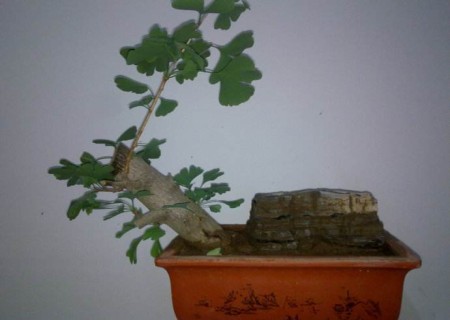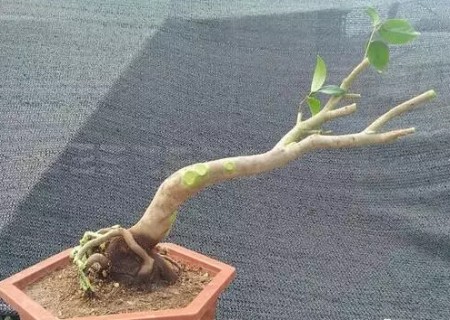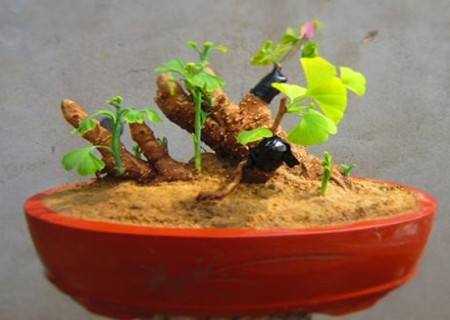Grafting technique of Ginkgo biloba potted plant
Ginkgo is a long-lived tree, not only slow growth rate, and flowering and fruiting very late, Ginkgo seedlings generally after 20 to 30 years of growth before flowering and fruiting, and low yield, poor quality. However, if grafting cultivation techniques are adopted, flowering and fruiting can be achieved in 2-3 years. Grafting propagation can not only bear fruit earlier, but also keep the excellent characters of female parent and dwarf tree type. Therefore, grafting is often used in Ginkgo cultivation, but how to improve the survival rate of grafting, through practice and investigation, it is considered that the following main technical measures should be mastered:

Control environmental factors
1. Temperature during grafting
Generally, the temperature of healing tissue formation is 18~25℃. High temperature and low temperature will affect the formation of healing tissue. In sunny days, high temperature, low air humidity, strong light, large evaporation, low grafting survival; cloudy days, relatively low temperature, high air humidity, weak light, small evaporation, are conducive to grafting survival.
2. Humidity during grafting
Humidity also has great influence on the formation of healing tissue, such as too little humidity, strong evaporation, reduced water content in grafting part, slow growth or even stop activity of cambium cells, so that plants die. However, if too much moisture, humidity is too large, easy to cause wound decay, affect survival.
3. Light during grafting
Under dark condition, the callus growing out of the cutting mouth was milky white and tender, and the rootstock and scion were easy to heal; under light condition, the callus was few and hard, light green and difficult to heal, and only the opaque part in the interface formed callus, which affected the survival opportunity and speed. Therefore, in grafting to understand the weather conditions, pay attention to avoid bad weather conditions, such as cloudy and low temperature, windy days, rainy and snowy days are not suitable for grafting, cloudy days, windless and humid weather is most suitable for grafting.
2. Choose good rootstock and scion
1. Selection of rootstock
3~4 years old thick and full, developed roots, fresh skin color, 2-3 years old seedlings are appropriate, because 2 years old seedlings have many branches and leaves, the seedlings with developed roots are rootstocks, and the thickness of scions cannot be too different. Its nutrient storage is rich, so the grafting survival rate is high, and the general survival rate is above 90%.
2. Selection of scion
Choose 1~4 years old branches with full development and full buds as scions. The length is generally based on the standard of retaining 3 buds. The scion should be cut flat. It is best to use it as soon as it is picked. Do not place it for too long. When the scion is cut, wax sealing treatment should be carried out immediately to prevent water loss.
1-year-old branches were collected from 30-40-year-old elite varieties in growing season as scions. As far as possible with the pick, long-distance transportation needs to pay attention to moisture, prevent decay, conditional can be stored at low temperature (3-5℃), can also be sealed wax moisture. Ginkgo biloba is dioecious, scion collection and storage should be based on different gender.
III. Use grafting technology well
1. Grafting method
Before rootstock and scion are detached, use split grafting or cutting grafting method, rootstock is detached but scion is not detached, use grafting method. Rootstock and scion are peeled by tongue grafting method, bud grafting method can be used in growth period.
Grafting takes place from late June to early August every year. When grafting, cut off from the new semi-lignification part of the rootstock, cut a vertical mouth with a sharp knife in the center of the cut, the mouth length is 2-3cm. 1 cm below the scion bud is cut into a wedge with symmetrical sides and a cutting slope length of 2- 3 cm, and then the wedge is cut from the bud 1 cm above to become a symmetrical wedge scion with single bud. Insert the scion into the rootstock incision quickly, align the smallest cambium of both sides, and tie it tightly with plastic strips in time, exposing the bud eye.
When conditions permit, a plastic bag (3-4cm in diameter and 10- 15cm in length) can be sleeved above the scion to prevent a large amount of water evaporation and play a protective role. Grafting time should be selected in cloudy days, low temperature, high relative humidity weather, but not in rainy days grafting. Grafting survival should be removed in time after the set of plastic bags. In addition, the nursery of grafted seedlings female and male plants should be distinguished.
2. Grafting period
Grafting can be carried out all year round. Practice has proved that spring grafting is the best time, because the weather is getting warmer at this time, the sap begins to flow from bottom to top, the cambium is active, and it is easy to survive after grafting. Generally, the grafting survival rate is higher from 10 days before "Qingming" to 5 days after "Qingming".
3. Grafting speed
The prepared scion long incision inward, short incision outward, quickly insert the rootstock, the cambium of the two must be completely consistent, and the rootstock cut open skin, is attached to the scion outer incision, righting and pinching tightly. Then use plastic film to tie tightly. According to the thickness of each rootstock, 1~3 scions can be grafted. In order to prevent rain and transpiration, it is beneficial to survival. The scions can be bound with bags.
IV. Pay attention to post-succession management
After grafting, it should be removed in time to prevent diseases and insect pests, and the pillars should be erected after the branches sprout. When the soil is dry, it is necessary to water it in time to ensure the normal supply of water. In addition to applying sufficient base fertilizer, thin fertilizer should be applied frequently when topdressing (such as liquid compound fertilizer, which can be sprayed once every 10 days or so, with spraying wet leaves as the degree), and loosening and weeding should also keep up.
Grafting survival can be grown in the original seedbed for 1 year, during which large fertilizer should be applied, foliar fertilization can be carried out, timely intertill weeding, and seedling growth can be accelerated. In the spring of the second year after grafting, transplanting was carried out according to the plant spacing of 30cm × 60cm. After 2 years, alternate rows and seedlings can be thinned to cultivate large seedlings of different specifications. Seedlings can be transplanted before and after frost.
Time: 2019-06-09 Click:
- Prev

Illustration of bonsai borehole grafting technique
Bonsai often has all kinds of defects or deficiencies, some roots and claws are good, but they are tall and straight, and there are too few branches. There are indeed a lot of difficulties in developing this kind of pile into bonsai of higher grade. In fact, long and straight can be bent and shrunk into an inch shape, and the lack of branch support can be transformed by grafting and pruning.
- Next

Seedling raising technique of twig grafting of Ginkgo biloba
Ginkgo biloba is a very ancient tree species with a history of hundreds of millions of years. Ginkgo biloba has high garden value, economic and medicinal value. Ginkgo biloba is widely planted at present, and the market supply of ginkgo seedlings is amazing every year. So how does ginkgo reproduce artificially?
Related
- Fuxing push coffee new agricultural production and marketing class: lack of small-scale processing plants
- Jujube rice field leisure farm deep ploughing Yilan for five years to create a space for organic food and play
- Nongyu Farm-A trial of organic papaya for brave women with advanced technology
- Four points for attention in the prevention and control of diseases and insect pests of edible fungi
- How to add nutrient solution to Edible Fungi
- Is there any good way to control edible fungus mites?
- Open Inoculation Technology of Edible Fungi
- Is there any clever way to use fertilizer for edible fungus in winter?
- What agents are used to kill the pathogens of edible fungi in the mushroom shed?
- Rapid drying of Edible Fungi

